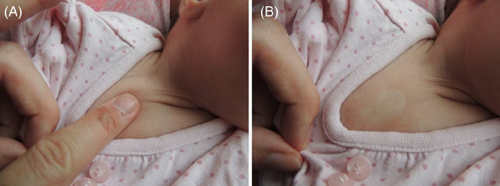Central Capillary Refill Time in Paediatrics
Assessment of paediatric patients can be challenging, due to many developmental and environmental factors. A complete physical assessment would include the patient’s heart rate, blood pressure, colour, central capillary refill time, respiratory rate, oxygen saturations, work of breathing, level of consciousness, temperature and pain score. However, if the patient is not compliant or the equipment is not appropriately sized this full assessment can be impossible!
The importance of Central Capillary Refill Time (CRT)
One of the most important assessment tools in rapid paediatric assessment is the central capillary refill time (CRT). It is quick, easy to perform and does not require any special equipment.
CRT is the time it takes for colour to return to a capillary bed after pressure has been applied to create blanching of the area. A normal CRT should be between 2-3 seconds when applied centrally, such as to the sternum or the forehead. Delayed CRT is indicative of circulatory shock or dehydration, and prompts further assessment and investigations.
Difficulties in performing a CRT include poor lighting and a cold environment, so take the time to ensure adequate lighting and temperature before performing the CRT.
Technique for measuring CRT
- Press one finger on the child’s sternum or forehead, applying pressure for 5 seconds
- Using a timepiece or counting aloud, measure the time in seconds that it takes for colour to return to the blanched area
- Document your findings, including the location and CRT
- If the CRT is greater than 3 seconds, this is an indication of poor perfusion, continue your clinical assessment and history to ascertain if there are any further signs of clinical deterioration. Further investigations will be guided by these findings and protocols.


Recommended related courses
If you are interested in updating your knowledge on paediatric assessment, you may be interested in joining us in one of our following courses depending on your area of clinical practice.
- Paediatric Assessment of Clinical Emergencies & Deterioration
- Paediatric Advanced Life Support courses
- Advanced Life Support courses
- Assessing the unwell child with the Paediatric Assessment Triangle
For a full list of events and courses please visit our courses page.
References
Fleming S, Gill P, Jones C, Taylor JA, Van den Bruel A, Heneghan C, Roberts N, & Thompson M. The Diagnostic Value of Capillary Refill Time for Detecting Serious Illness in Children: A Systematic Review and Meta-Analysis. PLoS One. 2015 Sep 16;10(9):e0138155. doi: 10.1371/journal.pone.0138155. PMID: 26375953; PMCID: PMC4573516.
King D, Morton R, & Bevan C. How to use capillary refill time. Archives of Disease in Childhood: Education & Practice, 2013 November, doi:10.1136/archdischild-2013-305198.

Crystal Smith is a Senior Education Consultant for Critical Care Education Services (part of the Medcast Group). She has a clinical background in critical care, paediatrics and education.
Become a member and get unlimited access to 100s of hours of premium education.
Learn moreSuccessful resuscitation attempts rely on the optimisation of cerebral and coronary perfusion. For this to occur it is important to work like a NASCAR pit crew and deliver high performance CPR.
Laser safety in operating theatres is crucial for staff and patient protection. Implementing training, protective eyewear, safety protocols, and controlled access ensures effective surgical procedures and minimises risks like tissue damage. Prioritising these measures enhances overall procedural safety and effectiveness.
Recognising and responding appropriately to student disclosure of sexual violence at educational institutes is urgently needed to mitigate the significant adverse mental and behavioural outcomes of such conduct.
